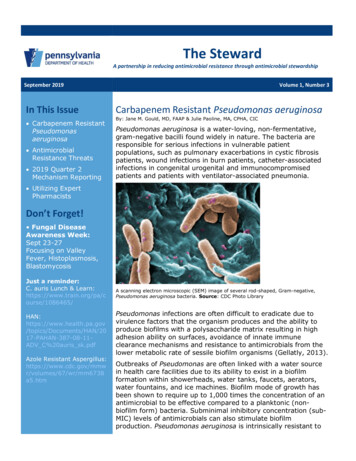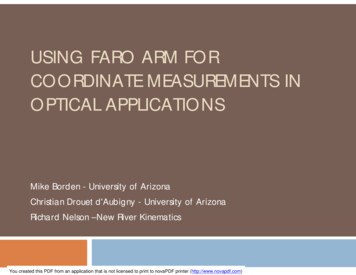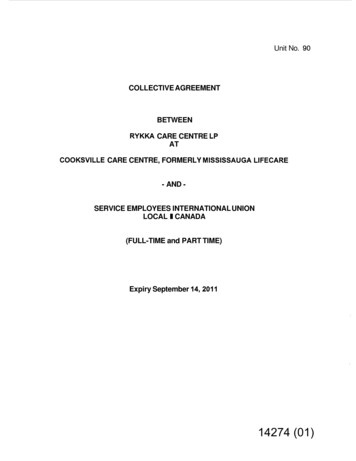
Transcription
The StewardA partnership in reducing antimicrobial resistance through antimicrobial stewardshipSeptember 2019In This Issue Carbapenem ResistantPseudomonasaeruginosa AntimicrobialResistance Threats 2019 Quarter 2Mechanism ReportingVolume 1, Number 3Carbapenem Resistant Pseudomonas aeruginosaBy: Jane M. Gould, MD, FAAP & Julie Paoline, MA, CPHA, CICPseudomonas aeruginosa is a water-loving, non-fermentative,gram-negative bacilli found widely in nature. The bacteria areresponsible for serious infections in vulnerable patientpopulations, such as pulmonary exacerbations in cystic fibrosispatients, wound infections in burn patients, catheter-associatedinfections in congenital urogenital and immunocompromisedpatients and patients with ventilator-associated pneumonia. Utilizing ExpertPharmacistsDon’t Forget! Fungal DiseaseAwareness Week:Sept 23-27Focusing on ValleyFever, Histoplasmosis,BlastomycosisJust a reminder:C. auris Lunch & Learn:https://www.train.org/pa/course/1086465/A scanning electron microscopic (SEM) image of several rod-shaped, Gram-negative,Pseudomonas aeruginosa bacteria. Source: CDC Photo nts/HAN/2017-PAHAN-387-08-11ADV C%20auris sk.pdfPseudomonas infections are often difficult to eradicate due tovirulence factors that the organism produces and the ability toproduce biofilms with a polysaccharide matrix resulting in highadhesion ability on surfaces, avoidance of innate immuneclearance mechanisms and resistance to antimicrobials from thelower metabolic rate of sessile biofilm organisms (Gellatly, 2013).Azole Resistant /mm6738a5.htmOutbreaks of Pseudomonas are often linked with a water sourcein health care facilities due to its ability to exist in a biofilmformation within showerheads, water tanks, faucets, aerators,water fountains, and ice machines. Biofilm mode of growth hasbeen shown to require up to 1,000 times the concentration of anantimicrobial to be effective compared to a planktonic (nonbiofilm form) bacteria. Subminimal inhibitory concentration (subMIC) levels of antimicrobials can also stimulate biofilmproduction. Pseudomonas aeruginosa is intrinsically resistant to
InternationalInfection PreventionWeek: October 13-19 Global HandwashingDay: October 15 Lunch and Learn:PA DOH QuarterlyWebinar for HospitalInfectionPreventionistsOctober 22 at 12:00pm AntibioticAwareness Week:Nov 18-24News You Can Use Effective January 1,2020, newantimicrobialstewardshiprequirements will beapplicable to JointCommissionaccreditedambulatory healthcare organizationsthat routinelyprescribeantimicrobialmedications. This wasreported in the reportentitled “R3 Report:AntimicrobialStewardship inAmbulatory HealthCare”.some antibiotics and can acquire additional resistance duringantibiotic therapy (Carvalho, 2019 and Perez, 2012). Acquiredresistance can be mediated by enzymes, such as chromosomallymediated AmpC cephalosporinases that are usually repressed,but can be induced by cephalosporin use, and the easilytransferable plasmid mediated β-lactamases andcarbapenemases. Additional resistance mechanisms include lossor alteration of outer membrane porins, upregulation of effluxpumps and plasmid mediated aminoglycoside-modifyingenzymes. If a biofilm form of the organism also acquires aplasmid that harbors a carbapenemase gene (such as blaSPM-1),this combination of a metallo-β-lactamase and biofilm capabilitiescan make the bacteria even more resistant to antimicrobials.Biofilm mediated resistance has also been shown for polymyxin B,one of the last-resort antimicrobials for this organism (Carvalho,2019).Carbapenem-resistant Pseudomonas aeruginosa (CRPA) is one ofthe resistant organisms defined by the World Health Organization(WHO) as a critical pathogen, since infections caused by them aredifficult to treat and have higher mortality rate (WHO, 2017). Arecent outbreak of Verona Integron-Mediated Metallo-Blactamase-producing CRPA (VIM-CRPA) was identified in U.Spatients who had invasive medical procedures in Mexico. As ofJanuary 2019, 12 cases were identified in seven states between2015 and December 2018. Six patients required hospitalization inthe U.S. for their VIM-CRPA infection and one died (Kracalik,2019). Although in the U.S., carbapenemase production inPseudomonas aeruginosa is less common than carbapenemaseproduction in Enterobacteriaceae (CP-CRE), it is still important toidentify the resistance mechanism in CRPA since the plasmidcarbapenemase genes are easily transferable to other organismsand the requisite public health response to prevent transmissionis very robust (Tier 2).The state public health laboratory began conducting mechanismtesting on CRPA isolates in December 2018. Since that time, 48CRPA isolates have been analyzed and none were found to becarbapenemase-producing. However, in 2018, an IMP-CRPA wasidentified in a patient at a Pennsylvania acute rehab facility afterbeing detected at the regional public health laboratory inMaryland.In conclusion, laboratorians should alert public health whencarbapenem-resistant Pseudomonas aeruginosa isolates areidentified. State or local epidemiologists will provide guidance andassist with coordination of isolates for mechanism testing, as wellas initiate the appropriate containment response as needed.
Congratulations toAllegheny GeneralHospital for beingdesignated as anIDSA AntimicrobialStewardship Centerof Excellence. Theyjoin UPMC Shadysidecampus as being theonly two hospitals inPennsylvania to holdthis designation.Applications to obtaina Center ofExcellencedesignation fromIDSA close onJanuary 31, 2020.Do You Have aSuccess StoryRelated to YourWork in AS/AR?We would love to featureyour facility or lab as asuccess story in a futureedition of The Steward!Please send a briefsummary related topreventing antimicrobialresistance or promotingstewardship activities toour resource mailbox atRA-DHHAI@pa.gov.Antimicrobial Resistance Threats, 2019 Quarter 2 DataBy: Pennsylvania Department of HealthFootnotes: CP-CRE is not yet reportable in Pennsylvania (PA). The cases identified abovewere obtained through voluntary reporting by healthcare facilities and laboratories,including the PA Bureau of Laboratories.Antimicrobial Resistance Threats, 2019 Quarter 2 DataBy: Philadelphia Department of Public Health, Division of Disease Control, Healthcareassociated Infections/ Antimicrobial Resistance ProgramFootnotes: CP-CRE is reportable in Philadelphia. *Philadelphia’s number for mCIMpositive with no genotype detected includes CRE isolates that were tested forcarbapenemase production in clinical laboratories but were not submitted for mechanismtesting by PDPH due to limitations in testing capacity and/or availability of isolate. Theseisolates may have tested positive for carbapenemase production via methods other thanmCIM (i.e. MHT, Carba-NP).
Opportunity toParticipate inAmbulatoryAntibioticStewardshipCollaborative:The Agency forHealthcare Research andQuality (AHRQ) SafetyProgram for ImprovingAntibiotic Use isrecruiting pediatric andadult ambulatory clinicsto participate in a free12-month program thatseeks to improveantibiotic prescribing.Please see this websitefor more ibiotic-UseUtilizing Expert Pharmacists By: Jane M. Gould, MD, FAAP &Christine L. Mulgrew, MPH, PhDThe contributions of a pharmacist trained in antimicrobialstewardship practices are critical to having a successful antibioticstewardship program (ASP). Unfortunately, developing expertiseamong existing staff or identifying a pharmacist to supportsmaller facilities can be a challenge. In time, it is anticipated thatevery ASP will have a board-certified pharmacist with postgraduate residency training or a fellowship training in infectiousdisease (Heil, 2016). In the meantime, infectious disease andstewardship trainings are available to hospital-based pharmacists.Trainings are provided through the Society for Infectious DiseasesPharmacists (SIDP) and the Making a Difference in InfectiousDiseases (MAD-ID) organization.See the table to determine whether your facility ranks “good,”“better” or “best”.According to the American Society of Health-System Pharmacists(2010), it is vital that pharmacists develop policies to improveantibiotic stewardship. The first improvement area is to promoteoptimal use of antimicrobial agents within the facility. This mayinclude developing policies that balance optimal therapeuticoutcomes with the risk of developing resistant strains ofmicroorganisms or this may include aiding in the appropriateselection, optimal dosing, rapid initiation, proper monitoring andde-escalation of antimicrobial therapies. The second improvementarea is to reduce healthcare-associated infections. Thepharmacist can advocate for use of single dose, sterile productsinstead of multi-dose containers and encourage routineimmunization among patients and facility staff. The finalimprovement area is educating staff, visitors and patients aboutantimicrobial stewardship and policies. Patients, their families andcaregivers should be educated about adhering to prescribed
Do You KnowAbout TRAIN PA?TRAIN PA is alearning managementsystem and is themost comprehensivecatalog of publichealth trainingopportunities forprofessionals. TRAINis a free service forlearners. TRAINcontains courses fromCDC and healthdepartments acrossthe United States.You will find live andprerecorded trainingshere as well as asearchable coursecatalog. There is alsoa built-in trackingsystem to track yourlearning on TRAINPA. Many coursesoffered here alsoinclude continuingeducation credits.antimicrobial use and how this integrates in the larger ASP.Examples of education can include providing newsletter articles,posters, and displaying computer screen savers to reinforce thismessage. Educating staff who prescribe is not alone effective.According to the literature (Bantar, 2003, Belongia, 2005, andGirotti, 1990), long-term change in prescribing behavior is onlyeffective when paired with an intervention. It is important toeducate prescribers when implementing stewardship policychanges that impact prescribing patterns.Small hospitals, nursing homes, long term acute care hospitalsand other small community hospitals with barriers to ASPadoption are encouraged to seek collaborative activities (Bhatt,2019). Numerous resources are available from key stakeholdersincluding: Agency for Healthcare Research and Quality (AHRQ),large hospitals/health systems and academic medical centers,hospital associations, federal, state, and local public healthorganizations, and federal and state offices of rural health.Example of a Pennsylvania Resource: Hospital and Healthsystem Association of Pennsylvania(HAP) continues to enroll acute care hospitals in itsAntimicrobial Stewardship Program. During the threeyears of this program, the collaborative has seenfluoroquinolone and carbapenem days of therapy (DOT)reduced by 34% and 35% respectively. For moreinformation on this program, contact Mary Catanzaro atmcatanzaro@haponline.org. Quality Insights anticipates working with all types offacilities, including physician practices, to improve ASPsbeginning later this Fall.To access TRAIN PA,just go to:https//www.train.org/pa/You will then need toclick on the “Createan Account” buttonfound on the leftside of the screen.Once you are logged in,use the search tool tolocate training topics orif you have a course ID,you can enter thatnumber.Antibiotic Awareness Week Seminars:Penn State University, November 19thDr. Louise Watkins, Centers for Disease Control and PreventionPenn State Health Milton S. Hershey Medical Center,December 3rdDr. Keith Hamilton, Children's Hospital of PhiladelphiaPediatric and Internal Medicine Grand RoundsUniversity of Pittsburgh School of Pharmacy, TBDSpeaker on Antibiotic StewardshipFor more information send email to:PAantimicrobialstewardship@gmail.comOpen to all
Antibiotic Use inthe United States:Progress andOpportunities, 2018Update: CDC releasedthis report, which is anupdate to CDC's 2017antibiotic stewardshipreport. Improvingantibiotic use isimportant to effectivelytreat infections, protectpatients from harmscaused by unnecessaryantibiotic use, andcombat antibioticresistance, one of themost urgent threats tothe public's health.Progress has been madein improving antibioticprescribing and use, butmany opportunitiesremain.Contact UsBureau of EpidemiologyHealthcare-AssociatedInfection Prevention &AntimicrobialStewardshipPennsylvaniaDepartment of HealthRoom 993, Health &Welfare Building625 Forester StreetHarrisburg, PA 17120717-787-3350RA-DHHAI@pa.govReferencesASHP Statement on the Pharmacist’s Role in Antimicrobial Stewardship andInfection Prevention and Control. Am J Health-Syst Pharm. 2010;67:575–7. tewardship.ashxBantar C, Sartori B, Vesco E, et al. A hospital wide intervention program tooptimize the quality of antibiotic use: impact on prescribing practice,antibiotic consumption, cost savings, and bacterial resistance. Clin InfectDis 2003; 37:180–6.Belongia EA, Knobloch MJ, Kieke BA, Davis JP, Janette C, Besser RE. Impact ofstatewide program to promote appropriate antimicrobial drug use.Emerg Infect Dis 2005; 11:912–20.Bhatt J, Smith B, Neuhauser MM, Srinivasan A, Moore P, Hyun D. CollaborativeSolutions to Antibiotic Stewardship in Small Community and CriticalAccess Hospitals. Acad Med. 2019; published ahead of Carvalho TDS, Perez LRR. Impact of biofilm production on polymyxin Bsusceptibility among Pseudomonas aeruginosa clinical isolates. InfectControl Hosp Epidemiol 2019; 40:739-740.Gellatly SL, Hancock RE. Pseudomonas aeruginosa: new insights intopathogenesis and host defenses. Pathog Dis. 2013 Apr;67(3):159-73.Girotti MJ, Fodoruk S, Irvine-Meek J, Rotstein OD. Antibiotic handbook and preprinted perioperative order forms for surgical antibiotic prophylaxis: dothey work? Can J Surg 1990; 33:385–8.Heil, EL, Kuti, JL, Bearden DR, Gallagher JC, society of Infectious DiseasesPharmacists and the American Society of Health-System Pharmacists.The Essential Role of Pharmacists in Antimicrobial Stewardship.Infection Control and Hospital Epidemiology 2016 Jul;37(7): 753-754.Kracalik I, Ham C, Smith A et al. Verona integron-encoded metallo-β-lactamaseproducing carbapenem-resistant Pseudomonas aeruginosa infections inU.S. residents associated with invasive medical procedures in Mexico,2015-2018. US Department of Health and Human Services/Centers forDisease Control and Prevention. Morbidity and Mortality Weekly Report.May 24, 2019, 68(2):463-464Perez LR, Antues AL, Freitas AL, Barth AL. When the resistance gets clingy:Pseudomonas aeruginosa harboring metallo-β-lactamases gene showshigh ability to produce biofilm. Eur J Clin Microbiol Infect Dis 2012;31:711-714.World Health Organization. Prioritization of pathogens to guide discovery,research and development of new antibiotics for drug resistant bacterialinfections, including tuberculosis. 2017. Available at:https://www.who.int/medicines/areas/rational use/prioritization-ofpathogens/en/
Allegheny General Hospital for being designated as an IDSA Antimicrobial Stewardship Center of Excellence. They join UPMC Shadyside campus as being the only two hospitals in Pennsylvania to hold this designation. Applications to obtain a Center of Excellence designation from IDSA close on January 31, 2020. Do You Have a Success Story Related to .











